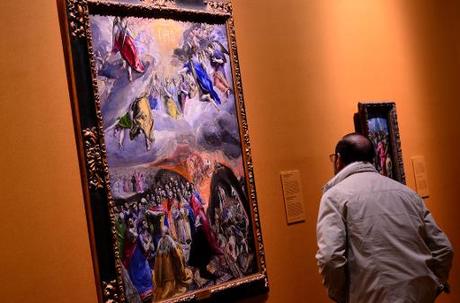Toledo Welcomes Back Painter Greco 400 Years on

The Spanish city of Toledo on Friday welcomed back the master painter El Greco, whose vivid works have returned from around the world to adorn his adoptive city 400 years after his death.
Organizers billed it as "one of the most important" shows ever curated of the Greek-born painter who made the Spanish city his home.
He is known for stirring religious scenes such as "The Burial of the Count of Orgaz" -- a particular gem that cannot leave the Santo Tome church in Toledo since it is too big.
But 64 other paintings from 31 cities are on loan until June 14 to the city, where they will hang in six venues, close to where El Greco intended them to be displayed.
Added to the dozens of works still kept in the historical city, they form around a third of the 300 paintings the old master created before his death on April 7, 1614.
n
Presenting the exhibition ahead of Friday's public opening, the head of the El Greco 2014 Foundation, Gregorio Maranon, said it was "the most important ever" show of the artist's paintings.
Born Domenikos Theotokopoulos in Crete in 1541, El Greco moved to Toledo at the age of 36 after being rejected by the court of Spain's King Philip II.
He was forced to accept all kinds of commissions to pay off his debts, producing numerous portraits and religious images in his workshop in Toledo.
His works languished in obscurity until they were brought to the attention of collectors in the late 19th century.
They transformed him into one of the most important figures in the history of art, considered by some to be a forerunner of Modernism.
His piercing colors and distinctive elongated human figures verge on the disturbing, but the curator of the Toledo show, Fernando Marias, said there is a brighter side to El Greco.
The new exhibition aims to give a modern view of "a painter who enjoyed painting beautiful things, in a highly beautiful way... not gaunt and emaciated figures," he said.
- Colour, space, beauty -
Visiting works include a portrait of Saint Mary Magdalene in a blue cloak, painted in 1576 and on loan from Barcelona. There is also a post-crucifixion scene, "La Piedad", from the same year, on loan from New York.
Those two works will hang in the gothic hospital of Santa Cruz in Toledo.
Restorers have removed layers of varnish and dirt from some works, offering a fresh view of El Greco, "whose colours consume us with their intensity", Marias said.
Another site to open its doors is the private chapel of San Jose.
There, two canvases form a gilded altarpiece decorated with cherubs and sculptures designed by El Greco -- a little-known facet of his work.
"He planned his works to be incorporated into the space," so it is important "to see these paintings in their original setting," said the director-general of the foundation, Jesus Carrobles.
"Some of them were meant to be hung high up, in which case the figures do not look so disproportionately elongated," he explained.
El Greco's distinctive long-limbed saints and characters were not due, as some have suggested, "to poor eyesight, but to a deliberate effect to represent his personal ideal of beauty", Carrobles added.
In his studio, flooded with southern light, the artist hung groups of clay figurines from the ceiling to paint them as angels in heaven, as seen in "The Adoration of the Shepherds".
That painting is also thought to contain El Greco's self-portrait.
Kicking off a year of El Greco commemorations, the Toledo exhibition is followed by another in Madrid's El Prado museum from June 24 to October 5, which will examine his influence on 19th- and 20th-century painting.



